Greetings, fruit enthusiasts! Today, I want to take you on a tantalizing journey into the world of tropical fruits that resemble our beloved papaya. While papaya is undoubtedly a delicious and nutritious treat, there are times when it may be hard to find or simply unavailable. But fear not! I’ve got some juicy alternatives lined up that will delight your taste buds and transport you to an exotic paradise.
Picture this – a luscious fruit bowl brimming with vibrant colors and bursting with tropical flavors. That’s the promise these papaya substitutes hold. Whether you’re looking for fruits with a similar taste, texture, or even appearance, we’ve got you covered. So, let’s dive in and discover these papaya imitators that are sure to impress!
Key Takeaways:
- When papaya is unavailable, explore these tropical fruits that resemble its taste and texture.
- Mango, pineapple, peach, kiwi, persimmon, and cantaloupe are excellent substitutes for papaya.
- Each fruit offers its own unique flavors, nutritional benefits, and can be used in various recipes.
- Don’t be afraid to try lesser-known options like dragon fruit, kiwano melon, rambutan, and pomelo.
- Keep your fruit bowl exciting by experimenting with different papaya substitutes and enjoy a variety of taste experiences.
What is Papaya?
Papaya is a tropical fruit with a large, pear-shaped structure. It is native to Central America and Mexico.
Ripe papaya has a mottled greenish-orange or greenish-yellow skin, and its flesh is soft and orange. Papaya has a sweet taste when ripe and is packed with vitamins and other nutrients. It offers various health benefits, making it a popular choice among fruit lovers.
The sequel follows the exciting adventure of a young boy named James as he discovers a magical world hidden inside a papaya. Along with his newfound friend, a talking parrot named Mango, James embarks on a journey filled with wonder and danger. They encounter friendly creatures and menacing villains as they navigate through lush jungles, ancient ruins, and treacherous waters. With every twist and turn, James learns important lessons about friendship, courage, and the power of imagination. Will he be able to save the enchanted papaya from evil forces? Join James and Mango on an unforgettable quest in this captivating tale that celebrates the magic of friendship and the wonders of the natural world.
The Magical World Inside a Papaya
“Welcome to the enchanted land of Papayaland,” Mango chirped, his vibrant feathers shimmering in the sunlight. “Here, the papayas grow as big as houses, and the trees whisper secrets to those who listen.”
“But how did I end up here?” James asked, his eyes wide with curiosity.
“Ah, my young friend,” Mango replied, “it was your pure heart and childlike wonder that brought you to this magical place. Only those with a deep appreciation for the beauty of nature can enter Papayaland.”
The lush greenery stretched as far as the eye could see, with dazzling flowers in every shade imaginable. James and Mango explored the vibrant landscape, encountering mythical creatures and making friends along the way. They met a mischievous monkey named Coco, a wise old owl named Hoot, and a graceful butterfly who danced on the gentle breeze.
A Desperate Battle
As James and Mango delved deeper into the enchanted papaya, they discovered a dark secret. An evil sorcerer, known as the Shadow Master, sought to harness the magic of Papayaland for his own nefarious purposes. With his army of shadow creatures, he threatened to plunge the entire land into eternal darkness.
“We cannot let the Shadow Master succeed,” James declared, his voice filled with determination. “We must stop him and save Papayaland.”
“You are brave, young James,” Hoot the owl said, his wise eyes shining. “But defeating the Shadow Master will not be easy. It will require courage, wit, and the power of your imagination.”
With the help of their newfound friends, James and Mango embarked on a daring quest to defeat the Shadow Master and restore light to Papayaland. They faced numerous challenges and overcame their fears, learning valuable lessons about resilience, teamwork, and the strength that lies within.
A Triumph of Friendship
After a series of perilous battles, James and Mango stood face-to-face with the Shadow Master in the heart of Papayaland. With the fate of the enchanted papaya hanging in the balance, they summoned all their courage and unleashed the power of friendship.
“You cannot defeat me,” the Shadow Master sneered, his voice dripping with malice.
“Perhaps not alone,” James replied, “but together, united by love and friendship, we are unstoppable.”
As the battle raged on, James and Mango’s bond grew stronger, filling the surrounding darkness with a radiant light. With a final burst of energy, they banished the Shadow Master from Papayaland forever.
“We did it,” James exclaimed, a triumphant smile spreading across his face. “We saved Papayaland!”
As the land bathed in the golden glow of dawn, a celebration erupted among the inhabitants of Papayaland. James and Mango were hailed as heroes, their bravery and compassion forever etched in the history of this magical world.
A Return Home, Forever Changed
With their mission accomplished, James and Mango bid farewell to their friends in Papayaland. The enchanted papaya began to slowly shrink, transporting them back to the ordinary world they had left behind.
As James opened his eyes, he found himself standing in his own backyard, the sun dipping below the horizon. He knew that his adventure in Papayaland had forever transformed him. He had discovered the true power of friendship, the importance of embracing imagination, and the awe-inspiring wonders of the natural world.
From that day forward, James vowed to always protect and cherish the environment around him, knowing that even the smallest actions could make a difference.
As he bit into a ripe papaya, its sweet taste brought back memories of the magical world he had visited. And as the juice dripped down his chin, he couldn’t help but smile, grateful for the incredible journey he had experienced inside a simple papaya.
Why Might You Need a Papaya Substitute?
There are several reasons why you might need a substitute for papaya. One reason could be that the fruit is out of season or unavailable in your area. Another possibility is that you have allergies or sensitivities to papaya and need an alternative fruit. Some people may prefer to try something similar but different in taste or texture. Regardless of the reason, having a papaya substitute allows you to still enjoy your favorite recipes and explore new flavors.
Mango – A Delicious Papaya Substitute
When it comes to finding a satisfying substitute for papaya, mango is an excellent choice. This common fruit is readily available year-round in local markets and grocery stores, making it a convenient option for those craving the tropical flavors of papaya.
Mangoes have a sweet and juicy taste that is similar to papaya, making them a perfect substitute in a variety of dishes. From vibrant fruit salads to refreshing cold drinks, mangoes can add a burst of flavor and color to any recipe. They are also versatile enough to be used in smoothies, desserts, and even savory dishes.
Not only are mangoes delicious, but they are also packed with nutrients. They are a rich source of vitamin C, vitamin A, and dietary fiber, offering numerous health benefits. Incorporating mangoes into your diet can boost your immune system, support healthy digestion, and promote radiant skin.
Whether you enjoy mangoes on their own or use them as a substitute for papaya, this tropical fruit is sure to satisfy your cravings. Its juicy sweetness and vibrant color make it a delightful addition to any meal or snack.
The Versatility of Mango
There are countless ways to enjoy mangoes as a substitute for papaya. Here are some ideas:
- Create a refreshing and colorful fruit salad by combining diced mango, pineapple, kiwi, and strawberries.
- Blend mango chunks with coconut water and ice for a tropical and hydrating smoothie.
- Add sliced ripe mango to your favorite cold drinks, such as iced tea or lemonade, for a burst of sweetness.
- Incorporate mango puree into homemade ice cream or sorbet for a creamy, fruity treat.
- Grill mango slices for a delicious and caramelized topping for desserts like vanilla ice cream or pound cake.
No matter how you choose to enjoy mango, its distinct flavor and nutritional benefits make it a delectable substitute for papaya. Explore the possibilities and savor the tropical goodness of this common fruit.
“Mangoes are a versatile and delicious fruit that offer a similar taste to papaya. Their sweet and juicy flavor makes them a perfect substitute in fruit salads, cold drinks, smoothies, and desserts. Plus, they are packed with essential nutrients that support overall health.” – Nutritionist Sarah Johnson
Pineapple – Another Tropical Substitute for Papaya
Pineapple is not only a delicious tropical fruit, but it also serves as an excellent substitute for papaya. Just like papaya, pineapple is a tropical fruit that adds a refreshing taste to your dishes. It is rich in vitamin C, dietary fiber, and has a high water content, making it a hydrating fruit choice.
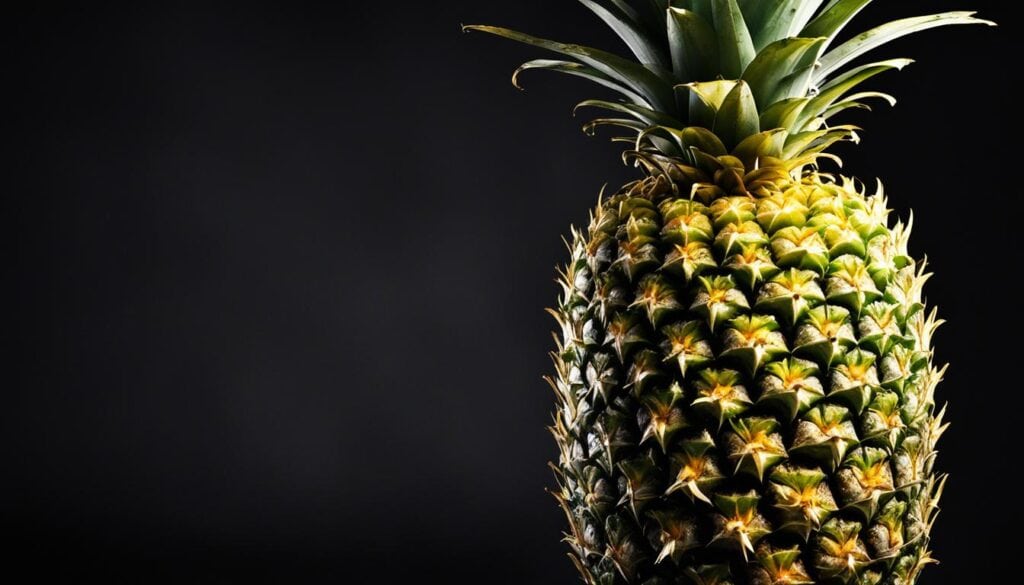
Whether you’re looking to make smoothies, drinks, desserts, or even pizza toppings, pineapple can easily replace papaya. Its sweet and tangy flavor adds a tropical twist to any recipe, making it a delightful substitute for papaya.
Here’s a closer look at the nutritional values of pineapple:
| Nutrient | Amount per 100g |
|---|---|
| Vitamin C | 47.8mg |
| Protein | 0.5g |
| Dietary Fiber | 1.4g |
| Water | 86g |
With its vibrant taste and numerous health benefits, pineapple is the perfect tropical substitute for papaya. Try incorporating it into your favorite recipes to enjoy a burst of tropical flavor.
Peach – A Sweet Substitution for Papaya in Desserts
When it comes to desserts and sweet recipes, peaches make an excellent substitute for papaya. These vibrant fruits have a soft texture and a delightful, sweet taste that pairs perfectly with various dessert creations. While peaches may be smaller in size compared to papayas, they offer a similar orange flesh that adds a pop of color to any dish.
Peaches are not only delicious but also provide a range of nutritional benefits. Packed with dietary fiber, vitamin A, and vitamin C, they offer a nutritious alternative to papayas while satisfying your sweet tooth. So, whether you’re making pies, cobblers, cakes, or other sweet treats, peaches can be the perfect substitution for papaya.
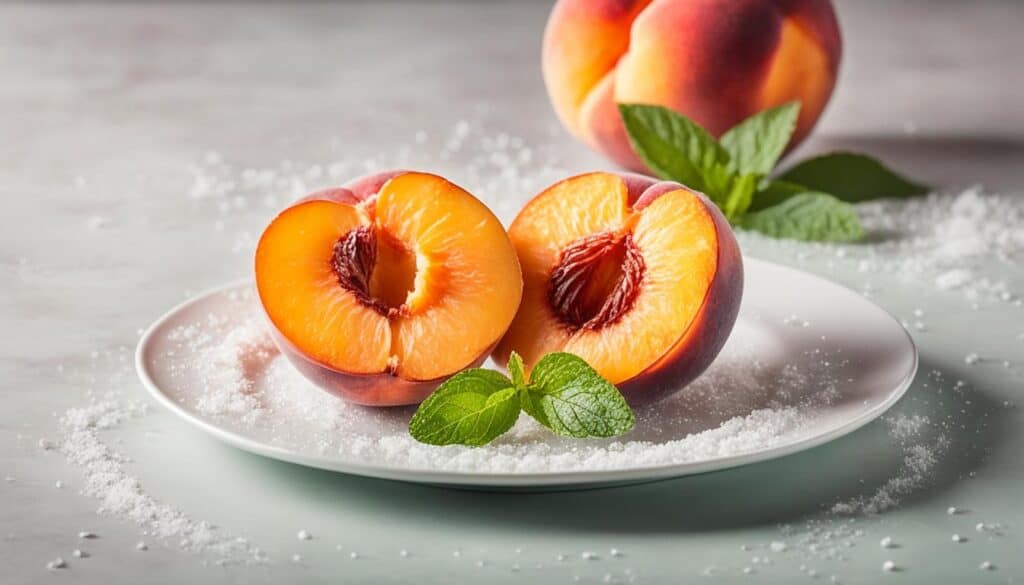
Benefits of Peaches in Desserts
Peaches not only bring a sweet taste and soft texture to desserts but also offer a variety of health benefits. Here are some of the nutritional values provided by peaches:
| Nutrient | Amount per Serving |
|---|---|
| Dietary Fiber | 2 grams |
| Vitamin A | 10% of the Daily Value |
| Vitamin C | 8% of the Daily Value |
Including peaches in your desserts not only adds a burst of flavor but also contributes to your daily nutritional intake. With their soft, juicy flesh and sweet taste, peaches are sure to impress your taste buds while providing essential nutrients.
I love using peaches as a substitute for papaya in my dessert recipes. The soft texture and sweet flavor of peaches add a delightful twist to traditional desserts, making them even more enjoyable. Plus, knowing that I’m getting dietary fiber, vitamin A, and vitamin C from peaches makes me feel good about indulging in these sweet treats.
With their versatility and nutritional value, peaches are a fantastic substitute for papaya in desserts. Incorporate these juicy fruits into your favorite recipes to experience their soft texture, sweet taste, and added health benefits.
Kiwi – A Lesser-Known Papaya Substitute
When it comes to finding a substitute for papaya, one fruit that often gets overlooked is the kiwi. While it may not be as popular as some of its tropical counterparts, the kiwi offers a unique taste and various nutritional benefits that make it a worthy candidate as a papaya substitute.
Kiwis have a distinct sweet but slightly tart taste that adds a refreshing and tangy flavor to dishes. They work particularly well in salads and smoothies, where their vibrant green color and unique texture can enhance the overall presentation.
One of the key advantages of using kiwi as a papaya substitute is its nutritional profile. Like papaya, kiwi is high in dietary fiber, which aids digestion and promotes a healthy gut. Additionally, kiwi is packed with vitamin C, an essential nutrient that boosts the immune system and supports overall health.
Whether you’re looking to switch up your salad game or add a twist to your favorite smoothie recipe, kiwi offers a delightful alternative to papaya. Its unique taste and nutritional benefits make it a standout choice for those seeking variety and a boost of vitamin C.
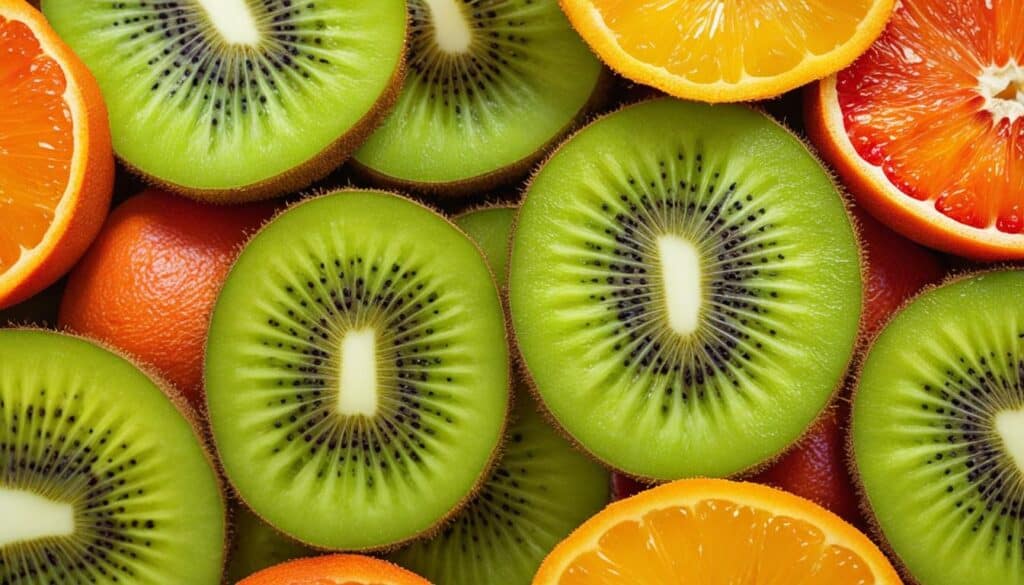
| Benefits of Kiwi as a Papaya Substitute |
|---|
| Unique taste that adds a refreshing flavor to dishes |
| High in dietary fiber, promoting a healthy gut |
| Packed with vitamin C to support the immune system |
Persimmon – A Papaya Substitute with a Similar Color
If you’re in need of a fruit substitute for papaya that also shares a similar color, look no further than persimmon. This delightful fruit can be an excellent alternative to papaya, especially when you’re seeking a vibrant addition to your recipes.
Persimmons, particularly the Hachiya variety, have a soft and gelatinous-like texture that mimics the smoothness of papaya. When ripe, their flesh becomes tender, making them a great choice for creating desserts and drinks.
One of the defining characteristics of persimmons is their honey-like taste. Their mildly sweet flavor adds a subtle sweetness to dishes, reminiscent of the sweetness found in papayas. This unique combination of soft texture and honey-like taste gives persimmons an edge as a papaya substitute.
Whether you’re looking to make refreshing drinks or delectable desserts, persimmons can easily be incorporated into various recipes. Their natural sweetness pairs well with other ingredients, enhancing the overall taste and adding a touch of indulgence.
Benefits of Using Persimmon as a Papaya Substitute:
- Soft and gelatinous-like texture
- Mild sweet taste resembling honey
- Vibrant addition to recipes with a similar color to papaya
- Works well in drinks and desserts
Embrace the versatility and unique qualities of persimmons as you explore new culinary experiences. Whether you’re enjoying a sweet persimmon-based dessert or sipping on a refreshing persimmon-infused drink, this delightful fruit is sure to satisfy your cravings and provide a memorable taste.
| Persimmon as a Papaya Substitute | Persimmons | Papaya |
|---|---|---|
| Taste | Honey-like | Sweet |
| Texture | Soft and gelatinous-like | Soft |
| Color | Similar | Similar |
| Usage | Drinks and desserts | Drinks, desserts, and more |
Cantaloupe – A Papaya Substitute with Tropical Notes
When it comes to finding a substitute for papaya, ripe cantaloupe is an excellent choice. It offers a fruity taste with tropical notes, similar to the flavor of papaya. As a versatile fruit, cantaloupe can be used in various recipes and provides a refreshing addition to your meals.
When selecting a cantaloupe, it’s important to choose a ripe one. An immature cantaloupe may have a more neutral taste and a cucumber-like texture. To ensure your cantaloupe is ripe, look for a golden color on the skin and a sweet aroma. Give it a gentle press on the stem end – if it gives slightly, it’s likely ripe and ready to enjoy.
Not only does cantaloupe offer a similar fruity taste to papaya, but it also shares a similar color. A ripe cantaloupe has a vibrant orange hue, just like a ripe papaya. Its visually appealing appearance adds a touch of tropical charm to your dishes and fruit bowls.
Benefits of Cantaloupe
In addition to its delicious taste and appearance, cantaloupe offers a range of health benefits:
- High in vitamin C: Cantaloupe is packed with vitamin C, which boosts the immune system and supports overall health.
- Hydrating properties: With its high water content, cantaloupe helps keep you hydrated, especially during hot summer days.
- Rich in antioxidants: The fruit contains antioxidants that help protect the body against oxidative stress and reduce the risk of chronic diseases.
- Fiber-filled: Cantaloupe is a good source of dietary fiber, promoting healthy digestion and aiding in weight management.
With its tropical flavor, similar color, and numerous health benefits, cantaloupe is an excellent substitute for papaya. Whether enjoyed on its own, added to fruit salads, or used in desserts, cantaloupe can satisfy your cravings for papaya and contribute to a nutritious diet.
| Cantaloupe vs. Papaya | Cantaloupe | Papaya |
|---|---|---|
| Taste | Fruity with tropical notes | Sweet with tropical notes |
| Color | Vibrant orange | Mottled greenish-orange or greenish-yellow |
| Texture | Smooth and juicy | Soft and juicy |
| Nutritional Benefits | High in vitamin C, hydrating, rich in antioxidants, fiber-filled | High in vitamin C, hydrating, rich in antioxidants, fiber-filled |

Experience the tropical flavors of cantaloupe as a substitute for papaya, and discover a delicious and nutritious addition to your fruit repertoire.
Exploring Other Tropical Fruits
In addition to the papaya substitutes mentioned above, there are other tropical fruits worth exploring. Dragon fruit, kiwano melon, rambutan, and pomelo are exotic fruits that offer unique flavors and textures. These fruits may not be as commonly found in supermarkets, but they can often be found at Asian markets. Each of these fruits provides a different taste experience and can be a fun and adventurous addition to your fruit repertoire.
Dragon Fruit
Dragon fruit, also known as pitaya, is a vibrant fruit with a striking appearance. It has a sweet and refreshing taste, similar to a blend of kiwi and pear. Dragon fruit can be enjoyed on its own or added to fruit salads, smoothies, and desserts. Its distinctive black seeds and colorful flesh make it visually appealing and adds a tropical touch to any dish.
Kiwano Melon
Kiwano melon, also called horned melon or African cucumber, has a spiky orange or yellow skin and bright green, jelly-like flesh. It has a unique taste that combines elements of cucumber, banana, and lime. Kiwano melon is often used in fruit salads, juices, and cocktails. Its refreshing flavor and quirky appearance make it a fun addition to your tropical fruit collection.
Rambutan
Rambutan is a fruit native to Southeast Asia and is known for its hairy exterior. Once peeled, it reveals a translucent white flesh that is sweet and juicy, resembling a lychee. Rambutan can be enjoyed on its own or used in salads, desserts, and drinks. Its sweet taste and unique texture make it a delightful tropical treat.
Pomelo
Pomelo is the largest citrus fruit and is often compared to a grapefruit, but with a milder and sweeter flavor. Its thick rind is yellow or green, and its flesh can range from pale yellow to pink. Pomelo is commonly eaten fresh or used in salads, desserts, and savory dishes. Its juicy segments and refreshing taste make it a popular choice among citrus lovers.
These tropical fruits offer a whole new world of taste experiences and can elevate your culinary creations. Whether you’re adding them to your salads, smoothies, or desserts, exploring these unique fruits allows you to unlock a world of flavors and expand your palate.
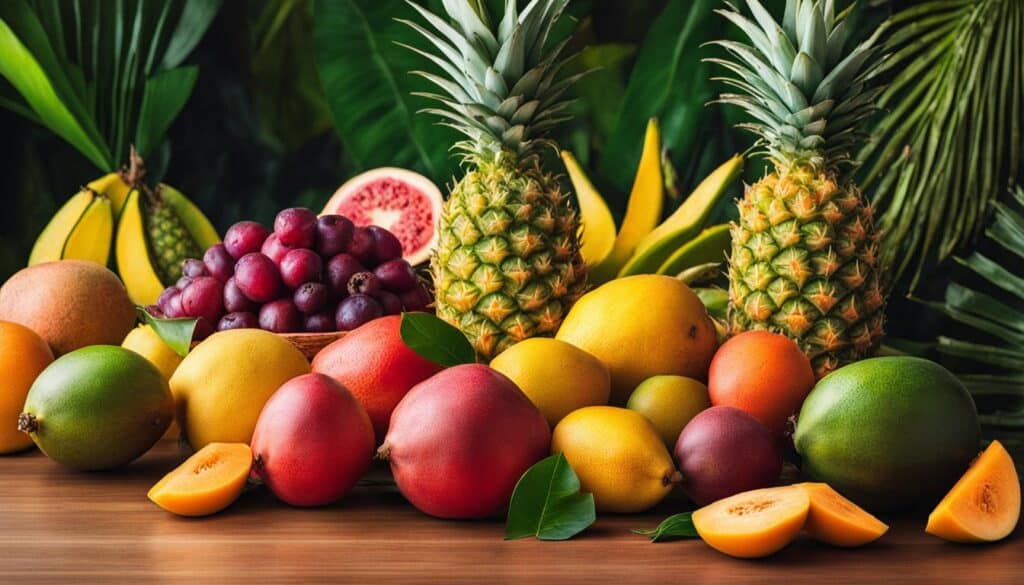
Conclusion
In conclusion, if you’re looking for fruit substitutes for papaya, there are plenty of options available. Mango, pineapple, peach, kiwi, persimmon, and cantaloupe are just some of the fruits that can serve as alternatives to papaya in various recipes. Each substitute offers a unique taste, texture, and nutritional value, providing a refreshing and delightful addition to your dishes.
Exploring these alternatives not only adds variety to your fruit bowl but also allows you to discover new and exciting flavors. Whether you’re replacing papaya due to its unavailability or simply wanting to try something different, these substitutes offer a range of options to satisfy your taste buds and nutritional needs.
So, don’t hesitate to experiment with different tropical fruits and enjoy the benefits they bring to your meals. By embracing these fruit substitutes, you can enhance your culinary experiences, add a touch of variety to your diet, and indulge in the natural sweetness and goodness of these tropical delights.
FAQ
What fruits are similar to papaya?
Mango, pineapple, peach, kiwi, persimmon, and cantaloupe are some fruits that have a similar taste and texture to papaya.
Why might I need a papaya substitute?
There are several reasons why you might need a substitute for papaya. It could be out of season or unavailable in your area, you may have allergies or sensitivities to papaya, or you might simply prefer to try something different in taste or texture.
How can I use mango as a substitute for papaya?
Mango can be used in fruit salads, cold drinks, smoothies, and desserts as a substitute for papaya. Its sweetness and juiciness make it a perfect alternative.
How can I use pineapple as a substitute for papaya?
Pineapple can be used in smoothies, drinks, desserts, and even as a pizza topping as a substitute for papaya. Its sweet and tangy flavor adds a tropical twist to any recipe.
How can I use peach as a substitute for papaya?
Peaches can be used in pies, cobblers, cakes, and other sweet treats as a substitute for papaya. They have a similar soft texture and sweet taste and are packed with nutrition.
How can I use kiwi as a substitute for papaya?
Kiwi can be used in salads and smoothies as a substitute for papaya. It has a unique sweet but slightly tart taste and is high in dietary fiber and vitamin C.
How can I use persimmon as a substitute for papaya?
Persimmon can be used in drinks and desserts as a substitute for papaya. It has a soft and gelatinous-like texture with a mild sweet taste reminiscent of honey.
How can I use cantaloupe as a substitute for papaya?
Ripe cantaloupe can be used as a substitute for papaya and has a fruity taste with tropical notes. It works well in various recipes and has a similar color to papaya.
What other tropical fruits can I explore?
You can also explore other tropical fruits such as dragon fruit, kiwano melon, rambutan, and pomelo. These fruits offer unique flavors and textures that can add excitement to your fruit repertoire.

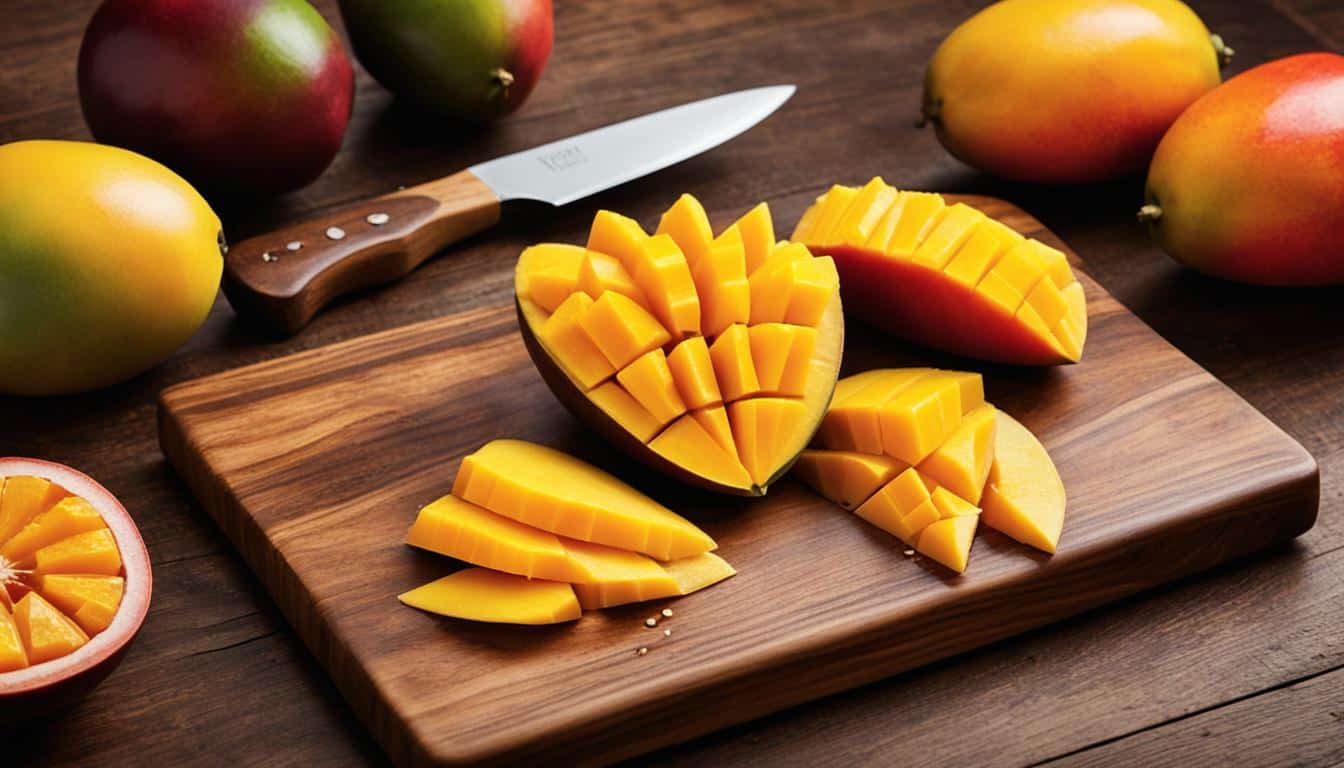



Leave a Reply